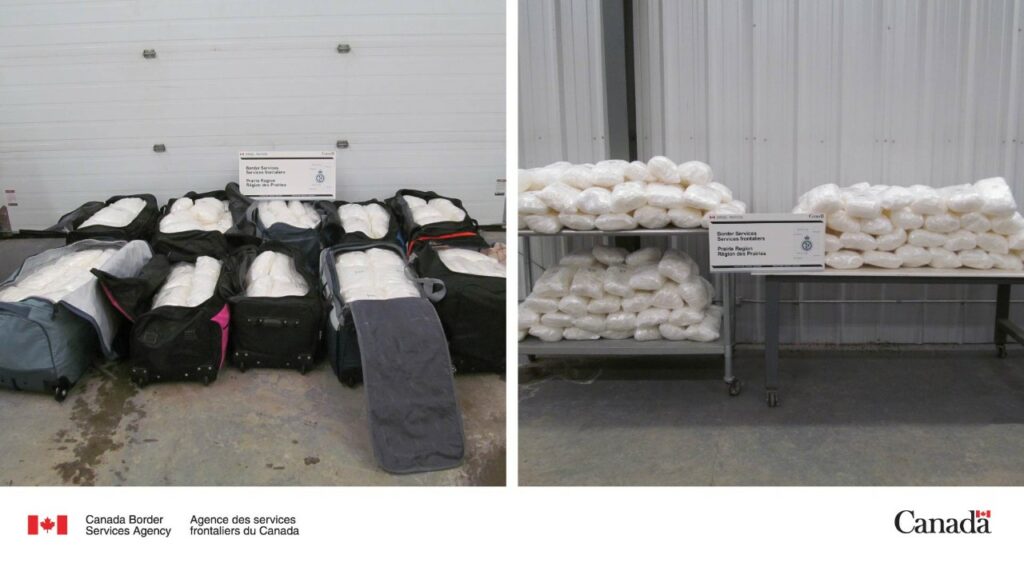Lure of a quick buck fuels drug smuggling in trucks
Drug traffickers find commercial trucks attractive as they provide a means to smuggle large quantities of contraband across borders. The inherent transient nature of the industry is a bonus, as equipment and drivers travel across the continent.
Tractors and trailers provide many hiding places for drugs as opposed to four-wheelers, said Mike Hinsperger of Frontline Commercial Vehicle Solutions. “It is a matter of scale, big trucks, big drugs,” said the former police officer, Commercial Vehicle Safety Alliance inspector, and court expert in commercial vehicle contraband concealment

Toronto couple charged after drug-laden truck stopped at border! CBSA seizes largest-ever quantity of drugs in Prairie Region from truck in Manitoba! Brampton trucker arrested in $6.5M drug bust at border! Border officers seize 65kg of cocaine from truck at Surrey crossing!
These are just some of the headlines of stories published by TruckNews.com in the past few months.
In 2023, Canada Border Services Agency (CBSA) officers intercepted more than 72,200 kg of prohibited drugs, cannabis, narcotics, and chemicals, representing an increase of 29% from 2022. And some of those drug busts involved commercial vehicles and drivers.
Greed and the lure of a quick buck propels truck drivers to smuggle drugs, Hinsperger said. Drug cartels pay drivers – or drug mules as he calls them – according to the level of risk and value of contraband they are hauling.
“It’s no different than hauling legitimate freight, you’re getting paid a percentage,” he said.
Drug traffickers are creative with places where then conceal contraband. “If you can think of a spot [to hide them], somebody already has,” Hinsperger said.
Creative concealment
A CBSA official told TruckNews.com that as smugglers become more creative in concealment methods, border services officers are trained to use a risk management approach to look for indicators to identify the presence of a controlled substance.
The agency also has detection tools and enhanced safety measures in place so that officers can safely and effectively detect, examine and interdict illegal drugs and precursor chemicals used to produce illegal drugs – as well as equipment used in illegal drug manufacturing – before they enter Canada.
Drivers can claim someone put the drugs in the truck, and the onus is on law enforcement and prosecutors in court to prove knowledge and possession. The idea that a criminal entity randomly selects a truck and stashes contraband into the load without the owner or driver’s knowledge is known as the blind mule concept.
The blind mule concept
“How are they going to get the drugs off the equipment without the driver or owner’s knowledge?” asked Hinsperger. “The concept of blind mule is absolutely preposterous and makes no sense.”
There are ways for trucking companies to protect their equipment and facilities from this scourge, Hinsperger said. They should know the location of trucks, trailers, drivers, and cargo. Drivers should be taking routes provided; if that is not happening, it is an anomalous activity.
Hinsperger highlighted the importance of video surveillance around trucking facilities. Companies can keep an eye on their equipment and staff with malicious intentions as well as intruders.
Criminal checks and credit reports
He said proper background checks on personnel are imperative. Criminal checks and credit reports can shed light on whether a candidate will or will not become an employee. “A driver with a huge debt burden could be willing to haul drugs for the money,” Hinsperger said.
How can a company ensure the integrity of the seal placed at the time of loading?
The shipper could provide a video of the seal being put in place and send it to the company. Additionally, showing the condition of the cargo and its loading before shutting the trailer doors would be an added layer of security. A damaged skid or ripped wrapping could be a sign of tampering.
Hinsperger said no one demographic can define a drug smuggler. He’s come across traffickers posing as drivers when he was in law enforcement. While talking to them during a stop, if they have no background or knowledge of trucking, it raises a red flag.
“There are also legitimate drivers who, for whatever reason, decide they want to involve themselves in this type of criminal behavior for a profit,” he said. “They are out there as well.”

Have your say
This is a moderated forum. Comments will no longer be published unless they are accompanied by a first and last name and a verifiable email address. (Today's Trucking will not publish or share the email address.) Profane language and content deemed to be libelous, racist, or threatening in nature will not be published under any circumstances.